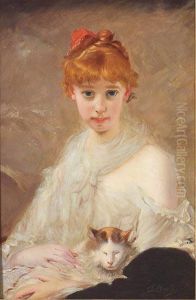Ennemond, Edmond Collignon Paintings
Ennemond Alexandre Edmond Collignon was a French artist and architect, born in 1852 in France. Despite not being widely recognized today, Collignon was an active figure in the French art scene during the late 19th and early 20th centuries. His contributions to architecture and the arts were reflective of the various movements and stylistic shifts that characterized that era, including elements of Art Nouveau and early modernism.
Collignon's early life was marked by his education in France, where he likely received traditional training in the arts. He pursued architecture as his primary discipline, which was a prestigious and intellectually rigorous field at the time. As an architect, Collignon would have been involved in the design and construction of buildings, contributing to the urban landscape in France. However, much of his architectural work remains lesser-known, and specific details about his projects are scarce.
Aside from his architectural endeavors, Collignon was also involved in the fine arts. He created artworks that may have included paintings, drawings, and possibly decorative arts, which were in vogue during the Art Nouveau period. This was a time when artists aimed to break down the barriers between the major and minor arts, striving to infuse everyday objects with aesthetic beauty and harmony.
Throughout his career, Collignon would have witnessed and perhaps participated in the various World's Fairs held in Paris, which were showcases for the latest developments in art and architecture. These events were crucial for architects and artists, as they offered opportunities to display their work and gain recognition. Collignon's work, whether in the form of buildings or other art pieces, would have been influenced by the international exchange of ideas that these exhibitions facilitated.
Ennemond Edmond Collignon passed away in 1922, at the age of 70. His legacy, like that of many artists and architects of his time, may have been somewhat overshadowed by the more dominant figures in art history. Nevertheless, Collignon's contributions to the French architectural and artistic landscape during his lifetime form part of the rich tapestry of the period's cultural history. Unfortunately, due to the lack of extensive records or a significant body of preserved work, his influence and the extent of his oeuvre are not well-documented, leading to a quieter historical footprint than some of his contemporaries.
